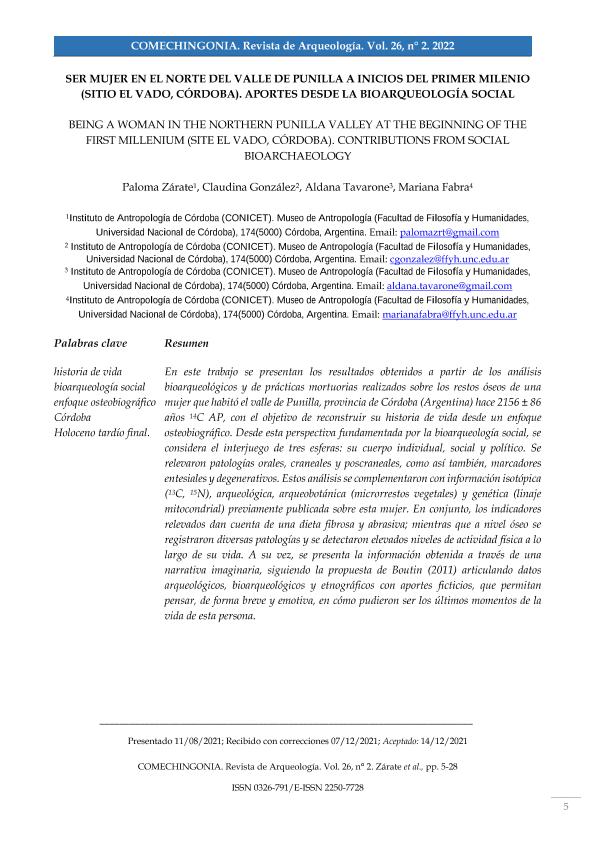Artículo
En este trabajo se presentan los resultados obtenidos a partir de losanálisis bioarqueológicos y de prácticas mortuorias realizados sobre los restos óseos de una mujer que habitó el valle de Punilla, provincia de Córdoba (Argentina) hace 2156 ± 86 años 14C AP, con el objetivo dereconstruir su historia de vida desde un enfoque osteobiográfico. Desde esta perspectiva fundamentada por la bioarqueología social, se considera el interjuego de tres esferas: su cuerpo individual, social y político. Se relevaron patologías orales, craneales y poscraneales, como así también, marcadores entesiales y degenerativos. Estos análisis se complementaron con información isotópica (13C, 15N), arqueológica, arqueobotánica (microrrestos vegetales) y genética (linaje mitocondrial) previamente publicadasobre esta mujer. En conjunto, los indicadores relevados dan cuenta de una dieta fibrosa y abrasiva; mientras que a nivel óseo se registraron diversas patologías y se detectaron elevados niveles de actividad física a lo largo de su vida. A su vez, se presenta la información obtenida a través de una narrativa imaginaria, siguiendo la propuesta de Boutin (2011) articulando datos arqueológicos, bioarqueológicos y etnográficos con aportes ficticios, que permitan pensar, de forma breve y emotiva, en cómo pudieron ser los últimos momentos de la vida de esta persona. This work presents the results obtained from the bioarchaeological and mortuary practices analysis carried out on skeletal remains of a woman who inhabited the Punilla valley, Córdoba province (Argentina) 2156 ± 86 years ago 14C AP, with the objective to reconstruct her life history from an osteobiographical approach. From this perspective, based on social bioarcheology, the interplay of three spheres is considered: the individual, social and political body. Oral, cranial, and postcranial pathologies were found, as well as entheseal and degenerative markers. These analyzes were complemented with previously published material on isotopic data (13C, 15N), archaeological, archeobotanical (plant microremains), and genetic (mitochondrial lineage) information. Altogether, the surveyed indicators show a fibrous and abrasive diet; while atthe bone level, various pathologies were recorded, and high levels of physical activity were detected throughout her life. In turn, the information obtained through a fictive narrative is presented, following the proposal of Boutin (2011) articulating archaeological, bioarchaeological and ethnographic data with literary contributions, which allow us to think, in a brief and emotional way, about the last moments of her life.
Ser mujer en el norte del valle de Punilla a inicios del primer milenio (Sitio El Vado, Córdoba): Aportes desde la bioarqueología social
Título:
Being a woman in the northern Punilla Valley at the beginning of the first millenium (Site El Vado, Córdoba): Contributions from social bioarchaeology
Fecha de publicación:
28/12/2021
Editorial:
Centro de Estudios Históricos "Profesor Carlos S.A. Segreti"
Revista:
Comechingonia
ISSN:
0326-7911
e-ISSN:
2250-7728
Idioma:
Español
Tipo de recurso:
Artículo publicado
Clasificación temática:
Resumen
Archivos asociados
Licencia
Identificadores
Colecciones
Articulos(IDACOR)
Articulos de INSTITUTO DE ANTROPOLOGIA DE CORDOBA
Articulos de INSTITUTO DE ANTROPOLOGIA DE CORDOBA
Citación
Zárate, Paloma; Gonzalez, Claudina; Tavarone, Aldana; Fabra, Mariana; Ser mujer en el norte del valle de Punilla a inicios del primer milenio (Sitio El Vado, Córdoba): Aportes desde la bioarqueología social; Centro de Estudios Históricos "Profesor Carlos S.A. Segreti"; Comechingonia; 26; 2; 28-12-2021; 5-28
Compartir
Altmétricas




